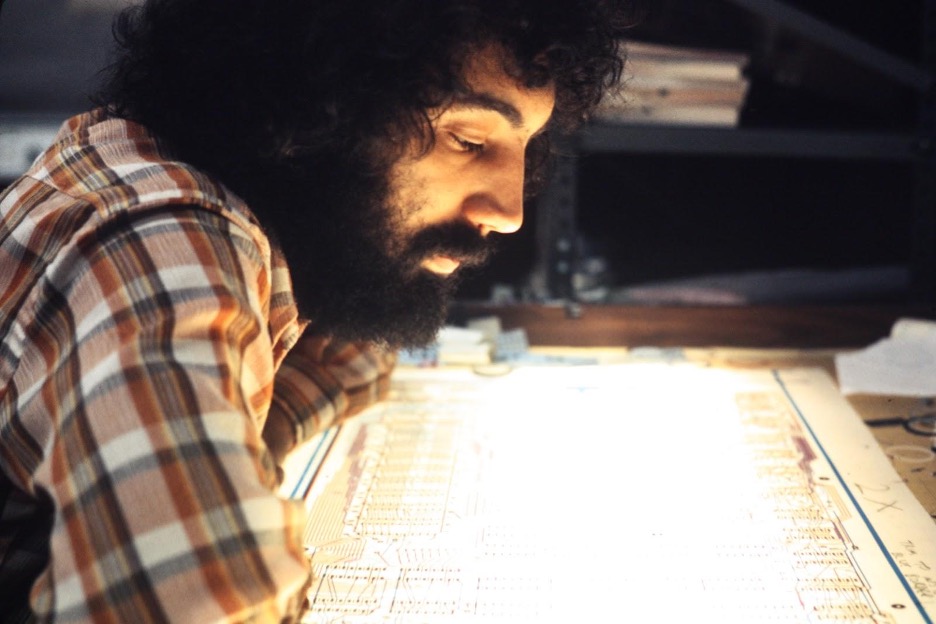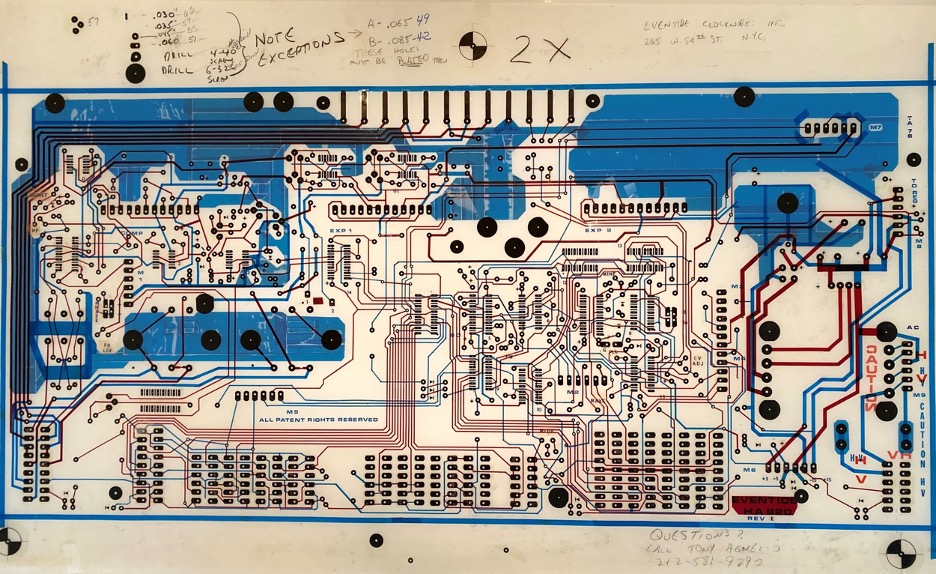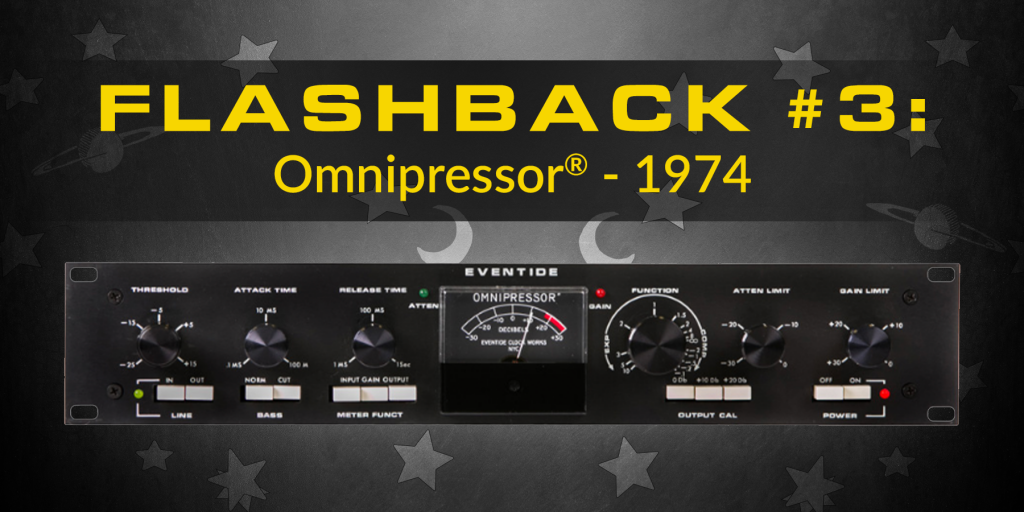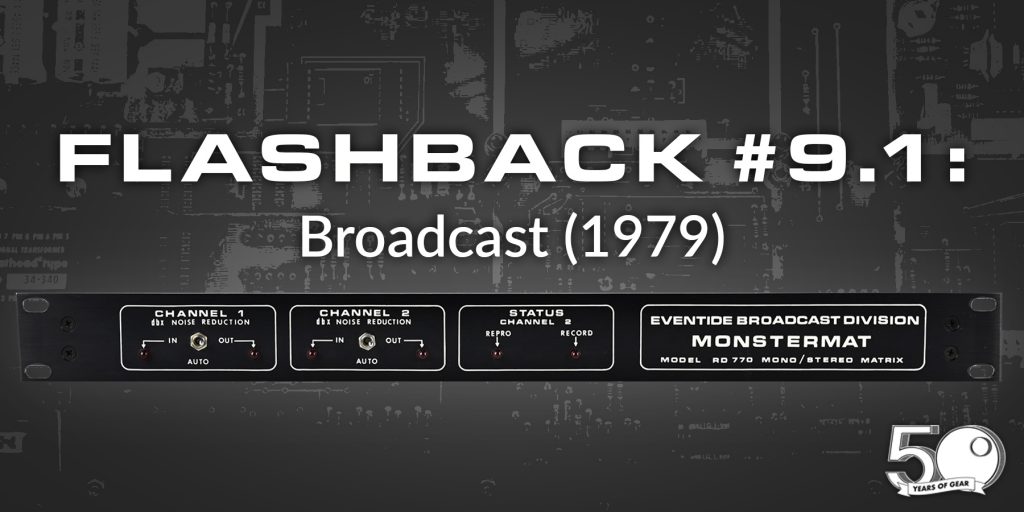
The H910
The H910 was arguably the first pro audio digital effects product. Prior to its introduction, studios had adopted digital delay as a utilitarian tool to replace the bother of using an expensive tape machine (and salaried tape op) for double tracking and plate reverb pre-delay. Eventide’s DDL1745M had an optional pitch change module and a handful of studios began to discover digital effects. However, the interface was not designed to easily dial in pitch-related effects, and there was a technical challenge to overcome.
The Challenge: Pitch Change Without Speed Change
By 1975, IC technology had sufficiently advanced to the point that it became practical to design a digital pitch change effects box — the H910. Random Access Memory ICs became commercially available and pitch change was made possible by reading the audio from memory (playing back) at a different rate than writing (recording). This is the equivalent of recording to tape at one speed and playing back at another speed. Of course, as with tape, the audio plays back at a faster or slower rate.
The challenge for a real-time pitch changer that does not change tempo is rather obvious. If you increase pitch by continuously reading from memory faster than you write to it, you’ll run out of data. If you continuously read from memory slower than you write to it, the delay will grow until you’ve completely filled up the memory. It helps to think of this as increasing pitch by decreasing delay and decreasing pitch by increasing delay. Delay can’t decrease past zero (that would require a magical digital “advance” line). Nor can delay be infinite. In fact, for real-time performance, it’s best to limit maximum delay to no greater than ~20 msec.
The Circular Delay Buffer
The ‘solution’ is both simple and imperfect. Use a ‘circular delay buffer’ of some length (typically 20-30 msec) with the delay abruptly jumping from zero to max in the case of increasing pitch (decreasing delay) and from max to zero in the case of decreasing pitch (increasing delay). Of course, the instantaneous jump results in a “discontinuity” in the audio signal. We called this the ‘glitch.’
The Glitch
What does the glitch sound like? How noticeable is it? Well, that depends on the pitch ratio and the audio source. For pitch ratios close to unison (pitch ratio ~1.00), the delay changes slowly and glitches occur infrequently. As the pitch ratio moves away from unison, the glitches occur more and more frequently. Since the audio on each side of the discontinuity cannot be controlled or determined, these glitches can be quite nasty, full scale clicks or complete drop outs.
Taming the Glitch
Full scale clicks or drop outs wouldn’t cut it for a piece of pro-audio gear. Plus, clicks would preclude feedback which was a key design feature to make arpeggiation and repeats possible. The innovation that tamed the glitch involved using a pair of offset delays, fading one in and the other out at the splice point. Two multiplying DACs were wired in parallel but fed from different points in the circular delay. The result was analogous to tape editing resulting in a splice, a crossfade, rather than a hard glitch or a drop out. This improved matters dramatically, although ‘soft’ glitches still resulted because if the time-shifted signals were 100% out of phase, they would cancel and one would still hear a drop out. On the other hand, if the signals were 100% in phase, the glitch would disappear. On the third hand, most of the time, the two summed signals were somewhat out of phase and the resulting soft glitching was less than awful. In fact, the glitch was embraced as a musical effect by some (thank you Laurie Anderson!).
The Eventide Sound
One of the things that set Eventide apart, all those years ago, was our skill in designing great sounding A to D converters. D to As are rather simple – that’s why the 1st consumer digital audio products – which didn’t appear until 1982! – were CD players. Playback is easy. Prior to the development and commercial availability of over-sampling ADCs in 1989 however, pro-audio quality ADC design was a true art. With each new Eventide product through the 70’s and 80’s we painstakingly improved our designs. The H910 used an advanced version of a technique developed by Richard Factor for the 1745 delay lines. A critically important characteristic of the technique was that it was inherently monotonic even for the quietest signal levels. Monotonic means that if the analog signal’s level is decreasing from sample to sample, the converter’s digital output would be a smaller and smaller number. The ear is rather forgiving of non-linearity in quiet passages but quite sensitive to non-monotonicity.
The Recipe: Delay, Pitch & Feedback
Thanks to the H910’s combination of selectable delay, pitch change and feedback in a simple to use rack mount chassis, artists quickly discovered new sounds and revolutionary effects.
For example, maximum delay and one interval of pitch change combined with feedback generates a musical progression from a single note – arpeggiation. Pitch change and feedback with no delay gives a rather strange robot or alien speech effect. Short delay with feedback but no pitch change gives a hollow flanging or tunneling effect, and long delay generates a distinctive reverb. Here’s how we described it in the original manual, ‘betting’ that “a Harmonizer will be used to audioize the BEM’s” (Bug Eyed Monsters):

Anti-Feedback
The front panel design was fairly primitive with buttons for setting delay time and knobs for controlling the basic functions of Mix, Pitch (labeled MAN) and Feedback. At the center of the panel was a three digit LED readout (7 segment LEDs were still new!). Tony has this ‘thing’ about symmetry and the panel had room for one more knob. He wasn’t sure what to add so he and Richard got to talking and came up with the cheeky notion of riffing off Feedback and adding an Anti-Feedback control.

With the ANTI-FEEDBACK knob set full counter-clockwise, pitch varied just slightly around unison. When set to MAX the pitch would vary several cents above and below unison.
The nomenclature wasn’t completely whimsical. With the ability to slightly vary the pitch around unison we thought that the H910 might be used to mitigate feedback-prone PA situations. We don’t know if anyone successfully used this feature for its intended application, but the slight, unstable, pitch shift was employed by many as an effective ADT (Automatic Double Tracking) tool.
Pitch Control
The H910 offered four ways of controlling pitch; two using the front panel knobs and two using remote control. The Keyboard introduced an innovative way of controlling pitch.

Press MAN and use the MANUAL knob to adjust pitch from one octave down (pitch = 0.50) to one octave up (pitch = 2.00). Press A-F to select the ANTI-FEEDBACK control knob. Select CV to apply a control voltage to set the pitch over a two octave range by applying a control voltage (remember this was ten years before MIDI was introduced). And, of course, there was the keyboard!
The Keyboard Option

The Keyboard introduced an innovative way of controlling pitch as envisioned by the beastly prototype. With KYBD selected the pitch could be set in musical intervals by Eventide’s optional two octave Keyboard. The Keyboard was unusual in that pressing middle C would set the Harmonizer’s pitch ratio to 1.00. Press the E above middle C and the Harmonizer would shift pitch up by a major third. Press the Eb above middle C and the Harmonizer would shift pitch up a minor third. In this way, the Keyboard was used as a controller to instantly shift audio up and down in half steps. Here’s an illustration from the original User Manual:

The Keyboard was designed to control up to three H910s making it possible for a vocalist to create three part harmonies live. A Glide control was provided for glissando.
The User Manual cautioned:

The Name: Full Disclosure
I was a 14 year old high school sophomore when The Beatles appeared on the Ed Sullivan show and, suffice it to say, it influenced my path. Over the years, from time to time, I’ve been asked about the model number, “why 910?” to which I’ve usually replied, “Well, it’s The One After 909!” And, that’s kind’a sort’a the truth but not the whole truth.
You see there’s more to it than just a reference to that Beatles’ song. In fact it’s a bit of an embarrassment and one I’ve kept secret until now. To start, I understood that the model number of one of Eventide’s earliest products was based on a birthday and, being a fan of John Lennon in particular, as a sort of homage, I decided to use his birthday as the model number for the box that I was designing. And, here’s where it goes just tad awry. Based on John’s handwritten note on the sleeve of my copy of the Plastic Ono Band LP, I thought that his birthday was September 10th!

I failed to take into account the British convention of day/month. Of course, his birthday is October 9th and so, if I hadn’t been so clueless, the Harmonizer would have been model H109.
The Artwork
Back in the days before CAD (Computer Aided Design) and personal computers, printed circuit boards were designed using blue and red mylar tape of various widths, black dots and razor blades. Here I am, circa 1974, laying out the artwork for the H910’s PCB:

And here is the Printed Circuit Board Artwork of the main board:

The H910 – The Sound of the C(os)MOS
The H910 was designed using primitive ICs (Integrated Circuits), the only ICs available at the time. Simple logic CMOS chips (Complementary Metal-Oxide-Semiconductor) performed the rudimentary arithmetic needed to store and retrieve digitized audio to and from the memory chips. Here’s a video demonstrating the many ways the CMOS-based H910 delights, frightens and confuses:
To learn more about the many uses (and misuses) of the H910, stay tuned for Part 3 of the Harmonizer story — Minds. Blown. Good. Evil.
Check out our previous flashbacks!
- Flashback #1: The Instant Phaser
- Flashback #2.1: The DDL 1745 Delay
- Flashback #2.2: The DDL 1745A Delay
- Flashback #2.3: The DDL 1745M Delay
- Flashback #3: The Omnipressor®
- Flashback #4.1: The H910 Harmonizer®
- Flashback #4.2: H910 Harmonizer® — The Product
- Flashback #4.3: H910 Harmonizer® — “Minds Blown”
- Flashback #5: FL 201 Instant Flanger
- Flashback #6: HM80 — The Baby Harmonizer®
- Flashback #7.1: The H949 Harmonizer®
- Flashback #7.2: H949 Harmonizer® — The New One
- Flashback #7.3: H949 Harmonizer® — Bending, Stretching, and Twisting Time
- Flashback #8: H969 Harmonizer®
- Flashback #9.1: Broadcast
- Flashback #9.2: Dump & Go – The Profanity Delay
- Flashback #10: Thinking Outside the Black Box


